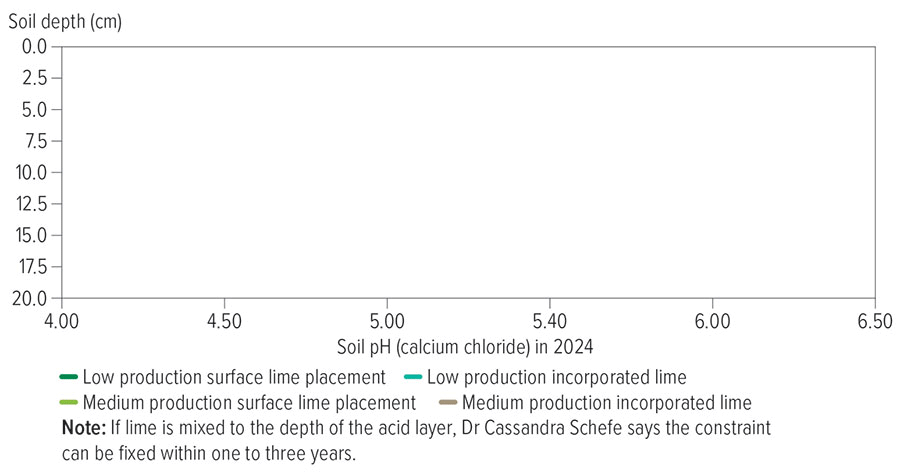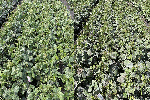Snapshot
Growers: Curt, Steph, Wayne and Anne Severin
Location: Brocklesby, NSW
Area farmed: 1200 hectares (owned and leased)
Annual average rainfall: 560 millimetres
Soil pHCa target: 5.8
Soil types: clay at depth, red-brown earths, gravel on rises
Topography: undulating
Typical crop rotation: wheat/canola
Curt Severin has incorporated lime using deep tillage to overcome an ‘acid throttle’ on the family’s mixed farm near Brocklesby in southern NSW.
In 2015, the family engaged Precision Agriculture Australia to collect zero to 10-centimetre soil samples on a two-hectare grid basis to check the soil pHCa. The company then made variable-rate lime maps to allow the input to be placed where it was most needed.
The property’s soil pHCa varied from 4.1 to 5.5 in the zero to 10cm layer.
“At that time, most people were targeting a soil pHCa of 5.2,” Mr Severin says. “But Charles Sturt University’s Dr Jason Condon and NSW Department of Primary Industries and Regional Development’s Helen Burns said we needed to target a pHCa of 5.8 to 6, so we decided to follow their advice.”
Acid throttle found
When Mr Severin learned about the importance of 5cm segmented soil testing, he used the technique and found an acid throttle in the 10 to 15cm layer.
The measured soil pHCa in one paddock was as low as 3.8 in the 10 to 15cm layer.
Part of that paddock had been given 4.5 tonnes per hectare of lime on a blanket basis the year before it was sampled, with the lime incorporated by sowing alone.
Mr Severin says the crops grown on this paddock from 2016 to 2019 were “pretty ordinary”, prompting him to question further what was limiting yields.
He observed that when incorporating lime at sowing, the tyned seeder was moving a lot of soil – but sideways rather than mixing it to the depth of the acid layer.
He contacted AgriSci director and soil scientist Dr Cassandra Schefe, the Cool Soil Initiative’s principal scientist.
The Cool Soil Initiative is a paddock-to-product supply chain partnership working with growers and regional farming groups to test and validate profitable farm management practices that reduce greenhouse gas (GHG) emissions.
Slaking clay
Dr Schefe told Mr Severin that while he should ideally mix lime to the depth of the acid throttle, a slaking clay layer 20cm from the surface should not be disturbed.
“Slaking is when macro soil aggregates break down into micro aggregates,” Dr Schefe says. “It’s like a mini explosion. When water directly hits that soil, the structure falls apart. Deep cultivation into this layer will result in long-lasting structural issues and poor trafficability.”
Before buying a deep tillage implement to incorporate the lime, Dr Schefe and Mr Severin travelled around his farm with a small bowl of water into which they placed clods of soil to check the location and depth of slaking and dispersive soils.
Dr Schefe says that slaking is evident by soil clods breaking down, causing dispersive soils to lose aggregation entirely with clay particles suspended in water, which causes cloudiness. “A soil can be slaking, dispersive or both.”
She says slaking cannot be fixed except with massive amounts of organic matter.
“Most of the slaking soil around Brocklesby is in the subsurface, so the simple rule is to keep it underground. If the slaking soil slowly receives water from another soil layer, it won’t slake.”
Mixing depth
After completing slaking and dispersion tests, Mr Severin knew the safe operating depth of the deep tillage was about 19cm beneath the surface.
Knowing this, in 2021, he bought a deep tillage machine – a LEMKEN Rubin 12 compact disc harrow – that he could confidently set up to mix the lime no deeper than 19cm.
He blanket applied 1t/ha of lime to paddocks that had received lime on a variable-rate basis 12 months previously and 2t/ha to paddocks that had received lime on a variable rate more than two years previously.
He then used the LEMKEN machine to incorporate lime to a depth of 15 to 18cm.
Initial issues
Mr Severin initially had trouble sowing the treated soil in the first year with his parallelogram seeder set on 300-millimetre row spacings with a paired row seeding boot, but these issues have been overcome.
In the first year, he says the soil was so soft that buried stubble wrapped around the knife-points at the rear of his seeder, burying the front rows of seed under soil and herbicide.
Since then, he has used a KB Rotacon Grader Board to level and consolidate the surface before sowing, preventing bulldozing of soil and stubble and moisture loss in the top 50mm.
“Now and then, the LEMKEN hit slaking soil, but the areas were only about the size of a farm ute. That soil is bright orange,” he says.
“In the first crop we sowed after incorporating the lime, we could see lower yields where the slaking soil was brought to the surface.”
In 2022 and 2023, he blanket applied 2t/ha of lime and mixed it to a depth of 15 to 18cm below the surface.
Focus paddock
The Severin family’s farm also incorporates a focus paddock monitored for the past three years through the Cool Soil Initiative to determine the effects of lime applied to the surface versus lime incorporated using deep tillage (Figure 1).
Figure 1: Soil pH (calcium chloride) measured in 2024 from lime applied to the surface versus lime incorporated using deep tillage in 2021.

Source: Cool Soil Initiative
Mr Severin left patches within the paddock where lime was left on the surface so they could be compared with the remainder of the paddock where lime was incorporated with deep tillage. He used a five-year aggregated normalised difference vegetation index (NDVI) map to find consistently low and medium areas in the paddock.
“We left 50-metre squares in the paddock to represent each zone,” he says. “We took soil samples in the middle of each zone and samples just outside each zone for three years to check pHCa.”
Dr Schefe says the paddock has been a focal point to demonstrate that incorporation done well accelerates the beneficial effects of applied lime.
“What we thought was a 10-year process of broadcasting lime on the surface and then incorporation by sowing alone, we now know was the result of just not putting on high enough lime rates to do the job properly,”
she says.
“We now know that mixing it to the depth of the acid subsurface is critical.”
Soil pHCa target
Dr Schefe says a simple way to test how the lime has been mixed through the soil is to use a shovel to cut an exposed face and apply the solution from a pHWater test kit directly onto the soil.
“A high pHWater produces a purple colour, and a low pHWater will appear yellow,” she says. “This will quickly indicate the depth to which the lime has been mixed.”
Mr Severin expects to re-lime the paddock after about six years. He plans to apply the lime and run the LEMKEN through the subsurface perpendicular to the initial treatment to ensure an even mixing of the lime through the soil.
Liquid fertiliser
Another change the Severin family made was purchasing an Equalizer seeder in 2018. This seeder places seeds more accurately than their previous machine and includes a system to deliver liquid nutrients in the furrow.
Mr Severin sources a custom blend of nutrients. The blend is based on tissue samples collected from August to September.
Initially, the nutrients applied included sulfur, nitrogen, calcium, magnesium, zinc and copper. However, calcium has been removed since lime has been applied and incorporated.
“We saw small increases in yield using the liquid system in the dry 2018 and 2019 seasons,” he says. “But in 2020, we saw up to 1t/ha improvement in wheat yields by using the custom blend.” No trials were done in subsequent seasons.
He estimates incorporating high rates of lime to fix the acid subsurface soil and applying a custom blend of nutrients helped achieve average wheat yields of just more than 7t/ha in 2023. His genetically modified canola yielded about 3.4t/ha on average.
“The past four years have been spectacular. The lime, incorporation and custom blend of nutrients have paid for themselves.”
Phosphate mixing
Mr Severin says another benefit of deep incorporation of lime is that it has also helped to overcome stratified phosphate.
“The first paddock we deep sampled had crops that had underperformed from 2016 to 2019,” he says.
“But once we incorporated the lime, the phosphate only available in the top 5cm was mixed to a depth of 190mm, moving it to the depth of the plant roots.”
Dr Schefe says she has seen paddocks around Brocklesby go from producing 3t/ha wheat yields to 6t/ha wheat yields in the following year, simply because lime was incorporated to the depth of the acid throttle.
Mr Severin says other observations made after incorporating lime are that the following season’s crops are generally healthier and more even.
Program benefits
The Severin family has benefited from being involved in the Cool Soil Initiative for the past five years by having yearly benchmarks for the greenhouse gas (GHG) emissions from their wheat.
“We’re at the higher end regarding fertilisers, trace elements and herbicides,” Mr Severin says. “The program gives us an idea of where we’re tracking, and it’s a way of benchmarking our soil health.”
He says the program has shown reductions in some areas and gains in others.
“Our fuel consumption now, for example, is significantly less because we bought a Fendt tractor,” he says. “This is the case even though we’re now towing a machine three times the weight of our previous seeder.”
But, he says, he has increased his fertiliser rates in the past five years as he has tried to ensure the nitrogen bank is full.
Mr Severin hopes to trial variable-rate urea in the future. He is also considering a protein monitor to ensure he is not over-applying urea.
More information: Curt Severin, curtseverin@gmail.com;
Cassandra Schefe, cassandra@agrisci.com.au
Cool morning chat clarifies resilience indicators
On a cold and windy morning in April, three growers and a soil scientist examined one of Curt Severin’s paddocks in southern NSW.
Cool Soil Initiative’s principal scientist Dr Cassandra Schefe – also an independent soil scientist at AgriSci – was keen to chat with Cool Soil Initiative growers whose farms were located south of Wagga Wagga. They met up at Mr Severin’s focus paddock near Brocklesby.
“If growers are going to move toward low-emission, high-efficiency grain production, an acid throttle will not enable maximum use of inputs like urea,” Dr Schefe says.
“Incorporating lime isn’t just about fixing acid soil constraints; it is about building resilience into our farming systems.”
Acid soils lead to stressed plants, and Mr Severin had noted more disease and weeds in crops grown on soils that needed lime mixed to depth.
“Addressing soil pHCa is one of the key levers the grains industry has to increase production efficiency and reduce emissions,” Dr Schefe says.
“Lime is a CO2 emitter, so in the year of application, we see a jump in greenhouse gas (GHG) emissions.
“But we’ve made it clear to our corporate partners that liming is necessary to lead to
a long-term reduction in GHG emissions over time.”
On the Severin family’s farm, lime is applied in the same year canola is planted. However, until this year, GHG emissions have only been tracked in wheat.
More information: Cassandra Schefe, cassandra@agrisci.com.au
Read more: GroundCover story Partnership puts a measure on ghg emissions

























































